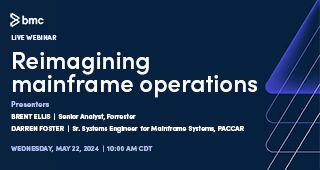As organizations strive to maintain continuous and resilient operations, mainframe systems play a crucial role in managing large-scale, mission-critical workloads. However, mainframe operators face numerous challenges: ensuring high availability, maintaining robust security, efficiently managing resources, and swiftly responding to incidents. These tasks become increasingly complex as the volume of data and demand for real-time processing grow and key skills become increasingly harder to source.
To overcome these hurdles, integrating advanced technologies like artificial intelligence (AI) and generative AI (GenAI) into mainframe operations can be transformative. This article explores how these variations of AI are used to enhance operational resilience, streamline processes, and optimize performance. We will also discuss the challenges faced by operations teams, including a lack of skilled staff with cross-domain expertise and the ability to get new operations team members up to speed quickly.
The role of AI in mainframe operational resilience
AI encompasses a wide array of technologies that enable machines to perform operational tasks that typically require human intelligence. From rules-based systems to sophisticated neural networks, AI consumes and digests vast amounts of data to “learn” and train itself to significantly enhance mainframe operations:
- Automation: One of the primary advantages of AI in mainframe operations is automation. Routine manual tasks often called “toil,” such as job scheduling, compliance audits, and system health monitoring, can be automated using AI. Allowing AI to handle these tasks reduces the potential for human error and increases efficiency, all at machine speed. For example, AI can automatically schedule batch jobs based on system load and priorities, ensuring optimal performance without manual intervention. This automation frees up operators to focus on more strategic tasks, enhancing overall productivity.
- Security: AI plays a vital role in enhancing the security of mainframe systems. By continuously monitoring for anomalies and potential threats in real time, AI helps safeguard the system against cyberattacks. Advanced AI algorithms can detect unusual patterns that might indicate a security breach, such as unexpected data access or unusual user behavior, and alert operators to take immediate action. This capability is crucial for maintaining the integrity and confidentiality of sensitive data. Prompt detection allows for swift resolution to prevent security breaches.
- Optimization: Resource allocation and workload management are essential for maintaining mainframe efficiency. AI can optimize these processes by dynamically adjusting resources based on current and predicted workloads. For example, AI can redistribute processing power during peak times to ensure critical applications receive the necessary resources without impacting overall performance. This optimization helps prevent performance degradation and ensures that the mainframe operates at peak efficiency.
- Anomaly detection: AI models excel at identifying anomalies in real time, which is crucial for maintaining operational resilience. By learning what constitutes normal behavior, these models are able to look across many key performance indicators (KPIs) and groups of KPIs to detect deviations that may indicate performance bottlenecks, security breaches, or system failures. It would take tens of millions of traditional thresholds—well beyond what a human or team of humans can monitor—to accomplish what AI can do innately.
- Real-time capacity planning: Effective capacity planning ensures that mainframe resources are scaled appropriately to meet future demands without overprovisioning. AI can analyze historical usage data to forecast future resource needs, helping operators make informed decisions in real time about CPU and resource allocation. This predictive capability prevents resource shortages and avoids unnecessary expenditures on excess capacity, ensuring that the mainframe infrastructure remains cost-effective and efficient.
- Data analytics: Advanced analytics powered by machine learning (ML) provide valuable insights into mainframe operations. By analyzing vast amounts of data, AI models can uncover trends and patterns that inform strategic decisions. For example, AI can predict system load based on historical data and business trends, enabling operators to proactively manage workloads and avoid performance issues. These insights drive data-driven decision-making, enhancing the overall efficiency and resilience of mainframe operations.
- Intelligent process automation: AI enhances process automation by learning from historical operations data and optimizing workflows. For instance, AI can automate the response to recurring incidents by identifying the most effective resolution steps based on past incidents. This intelligent automation reduces response times, lowers operational costs, and improves service delivery. By continually learning and adapting, AI ensures that automated processes remain effective even as operational conditions change.
Leveraging generative AI for mainframe operational resilience
Generative AI refers to AI systems that create new content based on the data on which they have been trained. This technology can generate human-like text, making it highly useful for various aspects of mainframe operations.
- Incident response and troubleshooting: By creating comprehensive reports and suggestions for troubleshooting, GenAI assists operators in quickly resolving incidents. For example, a GenAI system can analyze error logs and system performance data to generate a detailed incident report, including potential causes and recommended actions. This capability speeds up the resolution process and ensures that incidents are handled efficiently, minimizing downtime.
- Explanation of the root cause of anomalies: Generative AI excels at explaining the root causes of anomalies found by other AI and summarizes all the data into a dialog that is crafted in a manner that is almost human, akin to having an expert guide through the troubleshooting process. It can generate detailed reports that pinpoint underlying issues, such as configuration errors, resource bottlenecks, or security breaches, providing operators with clear descriptions to address and rectify these problems promptly.
- User interaction: GenAI can power conversational agents that interact with operators and offer real-time assistance, troubleshooting tips, and detailed operational reports. These AI-powered agents can answer queries, guide operators through complex tasks, and provide instant access to operational data. This enhances support efficiency and ensures that operators have the information they need to maintain system resilience.
- Simulation and testing: Generative AI can create realistic test scenarios and data based upon human dialog, allowing programmers to thoroughly test mainframe operations under various conditions without extensive manual setup. This capability is crucial for validating system changes and ensuring that new configurations do not negatively impact performance. For instance, it can simulate high-traffic conditions to test the system’s ability to handle peak loads. This comprehensive testing helps identify potential issues before they affect live operations, ensuring continuous resilience.
- Documentation and knowledge management: Maintaining accurate and up-to-date documentation is essential for effective mainframe operations. GenAI can automate the creation of operational documentation like detailed manuals and troubleshooting guides based on the latest system updates and changes, ensuring that operators always have access to current information. This capability enhances knowledge management, enabling operators to quickly find the information they need to resolve issues and maintain operational efficiency.
Integrating AI and generative AI for comprehensive resilience
Integrating AI, AI/ML, and GenAI into mainframe operations provides a comprehensive approach to achieving operational resilience. Each technology offers unique capabilities that, when combined, ensure that mainframes remain robust, scalable, and adaptive to evolving business needs.
AI provides overarching automation and optimization, streamlining processes and enhancing security. By automating routine tasks and optimizing resource allocation, AI ensures that mainframes operate efficiently and securely. It introduces predictive insights and intelligent analytics, improving maintenance and process automation. AI models enhance anomaly detection, capacity planning, and data-driven decision-making, ensuring that mainframes can adapt to changing demands.
Generative AI offers advanced content creation for operational support, enhancing incident response, user interaction, and documentation. By generating comprehensive reports and realistic test scenarios, it ensures that operators have the tools they need to maintain system resilience.
Embracing AI technologies for resilient and future-ready mainframe operations
As organizations continue to rely on mainframes for critical operations, ensuring operational resilience is paramount. The integration of AI and generative AI provides powerful tools for transforming mainframe operations. From automation and predictive maintenance to advanced analytics and intelligent process automation, these technologies enhance efficiency, security, and adaptability. By leveraging the unique capabilities of each AI technology, organizations can ensure that their mainframes remain resilient, scalable, and ready to meet the demands of a dynamic business environment. Embracing these innovations not only addresses the challenges faced by mainframe operators but also paves the way for a more robust and efficient future.







